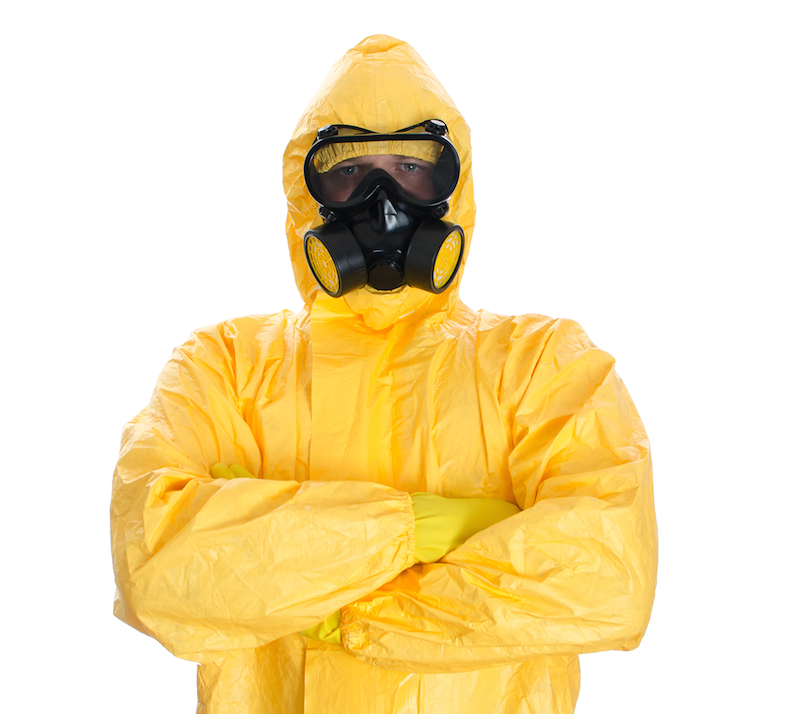Ebola Outbreak: Do Hazmat Suits Protect Workers, or Just Scare Everyone?

For health care workers and researchers, wearing pressurized, full-body suits around Ebola patients may be counterproductive to treating the disease, say three Spanish researchers in a new letter published in the journal The Lancet. But other health experts, wary of wearing less protective gear, disagree.
Health agencies often require that health care workers caring for Ebola patients wear hazardous material (hazmat) suits that protect against airborne diseases. But the Ebola virus rarely spreads through the air, according to the researchers at the University of Valencia and Hospital La Paz-Carlos III, in Madrid.
Ebola is transmitted through contact with infected patients’ secretions (such as blood, vomit or feces), and such contact can be prevented by wearing gloves and masks, the researchers wrote.
Wearing full-body protection gear is "expensive, uncomfortable, and unaffordable for countries that are the most affected," they said. It may also send the message that such protection against the virus is being preferentially given to health care workers and is out of reach to the general public, they wrote in their article. [Ebola Virus: 5 Things You Should Know].
Moreover, the image of health care workers in hazmat suits could lead to panic, causing people to flee the area and possibly spread the virus elsewhere, they added.
Instead, protective gear such as gloves, waterproof smocks, goggles, masks and isolated rooms may be enough to manage infected patients, so long as they are not hemorrhaging or vomiting, the letter said. "In control of infectious diseases, more is not necessarily better and, very often, the simplest answer is the best," the researchers wrote.
The current Ebola virus outbreak is the worst in history. It began in February 2014 in Guinea and has since infected people in Liberia, Nigeria and Sierra Leone, killing more than 1,500 people. Just 47 percent of infected patients have survived.
Sign up for the Live Science daily newsletter now
Get the world’s most fascinating discoveries delivered straight to your inbox.
But other experts disagree with the researchers, saying a high level of protection against the virus is needed in places with struggling health care systems, including the countries in West Africa where the outbreak is raging.
"The authors have a point, but I don't think a very strong one," said Dr. William Schaffner, a professor of preventive medicine and an infectious disease specialist at Vanderbilt University Medical Center in Nashville, Tennessee, who was not involved with the letter.
"It must indeed be unsettling for people to see folks in hazmat suits come into their communities," Schaffner told Live Science. "It's very foreign, and often increases their anxiety about events."
But it's better to err on the side of safety, he said. Because the Ebola virus does spread through contact with infected bodily fluids, if health care workers don't immediately clean up such excretions, it's possible these fluids could infect others not wearing appropriate protective gear.
Patients may also start vomiting or bleeding at any time, increasing the risk of infection for health care workers who are not wearing protective suits, he said.
"I would remind us that there are any number of health care workers, including Dr. [Kent] Brantly and Ms. [Nancy] Writebol, were using elaborate equipment in Africa and nonetheless became infected," Schaffner said. (Brantly and Writebol have both since recovered.)
In hospitals with cutting-edge technologies, such as Emory University Hospital, health care workers may not have to wear full-body suits for all Ebola patients, if the patients are on the mend, he said. If they are not displaying symptoms such as vomiting or bleeding, health care workers may be able to scale down their uniforms and use goggles and gloves in lieu of wearing hazmat suits, Schaffner said.
But "when you have a circumstance as hazardous as Ebola, it's important to be secure," Schaffner said.
The letter was published online Thursday (Aug. 28) in The Lancet.
Follow Laura Geggel on Twitter @LauraGeggel and Google+. Follow Live Science @livescience, Facebook & Google+. Original article on Live Science.

Laura is the archaeology and Life's Little Mysteries editor at Live Science. She also reports on general science, including paleontology. Her work has appeared in The New York Times, Scholastic, Popular Science and Spectrum, a site on autism research. She has won multiple awards from the Society of Professional Journalists and the Washington Newspaper Publishers Association for her reporting at a weekly newspaper near Seattle. Laura holds a bachelor's degree in English literature and psychology from Washington University in St. Louis and a master's degree in science writing from NYU.










